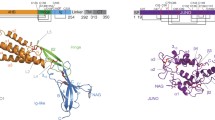Abstract
Egg–sperm interaction at fertilization marks the beginning of a new individual and allows the transmission of the genetic information to the next generation. Studied by scientists since the seventeenth century, this fundamental process has also long captured the attention of the public because of its direct relevance to reproductive medicine. However, how the female and male gametes recognize each other at the molecular level has until recently remained unknown. Using structural biology, we have found that—despite insignificant sequence identity—a common egg coat protein architecture mediates the initial interaction with sperm in mollusk and human, two organisms separated by 600 million years of evolution. Building upon this discovery, which revealed an expected link between invertebrate and vertebrate fertilization, we have determined the first three-dimensional structure of an egg coat–sperm protein complex. By visualizing the molecular details of the initial contact between gametes, this has both revealed how this interaction has made species-restricted and suggested a mechanism for sperm penetration through the egg coat (Raj et al. 2017). Together with recent data on a subsequent recognition step that ultimately triggers gamete plasma membrane fusion (Han et al. 2016; Ohto et al. 2016; Aydin et al. 2016; Nishimura et al. 2016), these studies started to unveil one of the most crucial moments of life at unprecedented detail.
Access provided by Autonomous University of Puebla. Download conference paper PDF
Similar content being viewed by others
Egg–sperm interaction at fertilization marks the beginning of a new individual and allows the transmission of the genetic information to the next generation. Studied by scientists since the seventeenth century, this fundamental process has also long captured the attention of the public because of its direct relevance to reproductive medicine. However, how the female and male gametes recognize each other at the molecular level has until recently remained unknown. Using structural biology, we have found that—despite insignificant sequence identity—a common egg coat protein architecture mediates the initial interaction with sperm in mollusk and human, two organisms separated by 600 million years of evolution. Building upon this discovery, which revealed an expected link between invertebrate and vertebrate fertilization, we have determined the first three-dimensional structure of an egg coat–sperm protein complex. By visualizing the molecular details of the initial contact between gametes, this has both revealed how this interaction has made species-restricted and suggested a mechanism for sperm penetration through the egg coat (Raj et al. 2017). Together with recent data on a subsequent recognition step that ultimately triggers gamete plasma membrane fusion (Han et al. 2016; Ohto et al. 2016; Aydin et al. 2016; Nishimura et al. 2016), these studies started to unveil one of the most crucial moments of life at unprecedented detail.
References
Aydin H, Sultana A, Li S, Thavalingam A, Lee JE (2016) Molecular architecture of the human sperm IZUMO1 and egg JUNO fertilization complex. Nature 534(7608):562–565
Han L, Nishimura K, Sadat Al Hosseini H, Bianchi E, Wright GJ, Jovine L (2016) Divergent evolution of vitamin B9 binding underlies Juno-mediated adhesion of mammalian gametes. Curr Biol 26(3):R100–R101
Nishimura K, Han L, Bianchi E, Wright GJ, de Sanctis D, Jovine L (2016) The structure of sperm Izumo1 reveals unexpected similarities with Plasmodium invasion proteins. Curr Biol 26(14):R661–R662
Ohto U, Ishida H, Krayukhina E, Uchiyama S, Inoue N, Shimizu T (2016) Structure of IZUMO1-JUNO reveals sperm-oocyte recognition during mammalian fertilization. Nature 534(7608):566–569
Raj I, Sadat Al Hosseini H, Dioguardi E, Nishimura K, Han L, Villa A, de Sanctis D, Jovine L (2017) Structural basis of egg coat-sperm recognition at fertilization. Cell 169(7):1315–1326.e17
Author information
Authors and Affiliations
Corresponding author
Editor information
Editors and Affiliations
Rights and permissions
Copyright information
© 2021 Springer Nature Switzerland AG
About this paper
Cite this paper
Jovine, L. (2021). First Snapshot of How Sperm Binds the Egg at the Molecular Level. In: Björndahl, L., Flanagan, J., Holmberg, R., Kvist, U. (eds) XIIIth International Symposium on Spermatology. Springer, Cham. https://doi.org/10.1007/978-3-030-66292-9_16
Download citation
DOI: https://doi.org/10.1007/978-3-030-66292-9_16
Published:
Publisher Name: Springer, Cham
Print ISBN: 978-3-030-66291-2
Online ISBN: 978-3-030-66292-9
eBook Packages: Biomedical and Life SciencesBiomedical and Life Sciences (R0)




